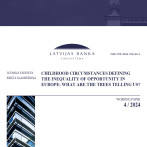Manufacturing in May: not much change
According to the data published by the Central Statistical Bureau, the amount of manufacturing production in May 2012 did not change substantially month-on-month (seasonally adjusted data), dropping 0.2%. A 7.3% growth was observed year-on-year. The rather long lived pendulum-like development of manufacturing, with the output growing one month and dropping the next, seems to have ceased. Both in the historical and current environmental contexts, the current output volumes continue at a very high level.
In the first five months of the year, the annual rate of growth has remained positive in the majority of sub-branches – in the manufacturing of textile products (+4.1%), wood and wood products (+8.7%), chemical substances (+33.3%), non-metal minerals (+7.5%), metals (+32.0%), fabricated metal products (+24.4%), electrical equipment (+22.1%) as well as others. The only negative growth rates are meanwhile observed in the production of food (-0.7%), wearing apparel (-9.6%), pharmaceuticals (-6.1%) and transport vehicles (-2.6%).
It was the branch's slightly improved confidence indicator (+0.9 points) that pointed to the probable lack of a substantial change in manufacturing output amounts in May. That should be considered as a mere adjustment after a substantial deterioration of the indicator in the previous month. Both the industry confidence regarding the level of new orders and the level of output expected in the future improved slightly. In June also the industry confidence indicator rose 0.9 points, yet in a breakdown by sub-branch the situation remained rather varied. Confidence levels remained positive in wood industry, the production of pharmaceuticals, metals was well as mechanisms and equipment. The confidence indicator remains negative in the production of food, construction materials, electrical and electronic equipment as well as transport vehicles and furniture. In most branches, the confidence levels relate well to the sub-branch output data.
Since the beginning of the year, the Latvian industry confidence indicator has improved by 1.5 points while the euro area indicator has deteriorated by 5.5 points, which indicates that in the future the Latvian manufacturing branch also could face problems in the form of fewer foreign orders. On the other hand, a certain trend is becoming increasingly pronounced – the deterioration of industry confidence indicators is primarily observed in the "problematic" parts of Europe, whereas in the North-Eastern region, the confidence indicators are improving. Thus it is +3.0 in Estonia, +1.2 in Finland, +4.8 in Sweden and +2.1 in the United Kingdom. True, in Lithuania there is a drop of 3.5 points. Such a group of countries with positive confidence indicators increasingly makes one consider the so-called "club" or two-speed development in Europe.
The industrial turnover trend in manufacturing has also fluctuated much in the first four months of the year, yet turnover has grown most rapidly in exports. Thus, since the beginning of the year, the manufacturing turnover in April grew 7.4%, including 3.3% in the domestic market, and 11.5% in exports. In a breakdown by branch, turnover has grown rapidly in the production of textile products (+22.4%), wearing apparel (+7.8%), chemical substances (+24.4%), farmācijā (+7.7%) and metals (+23.8%), which amounts to the greatest contribution to the growth of the branch.
It is primarily the rapid growth in metal production at the beginning of the year that has let manufacturing retain its upward trend. That was ensured by carrying out a large investment project at "Liepājas Metalurgs", which indicates yet again how important such projects are. At the moment there are no such projects amounting to 100 million in the branch, but there are several smaller ones that in the other half of the year should make a positive contribution to the growth of the amount of production in the branch. A hopeful sign is the variety that seems to be appearing in the structure of investments. That should ensure that after a while the specialization in the output of Latvian manufacturing, on the rise in the post-crisis period as the output of wood industry and metal industry went up rapidly, would gradually diminish. It is good to see that increasingly often it is one of the "second tier" branches – transport vehicle production, chemical industry, production of wearing apparel or pharmaceuticals etc. – that "shoots up" at least month-on-month.
Meanwhile, uncertainty remains in the background for any further development of manufacturing – all confidence indicators are creeping down and there is no solution in sight for the crisis in some of the euro area countries. Yet the manufacturing industry both in Latvia and our region at large has already shown that it can withstand the problems in Europe.
Textual error
«… …»






